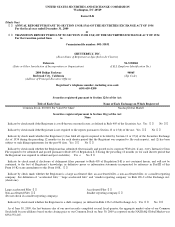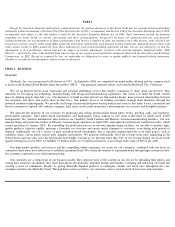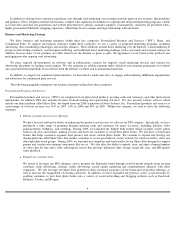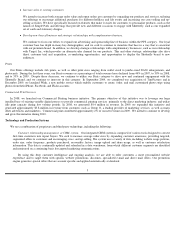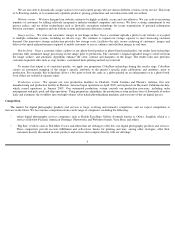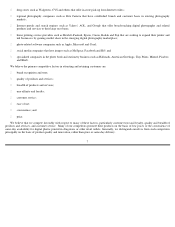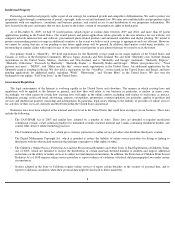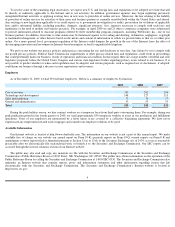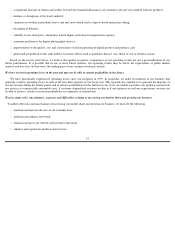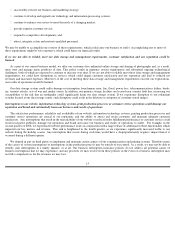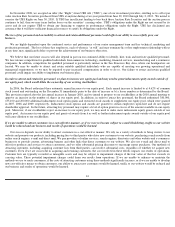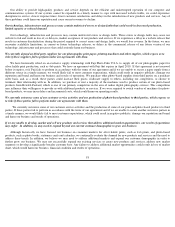Shutterfly 2010 Annual Report Download - page 10
Download and view the complete annual report
Please find page 10 of the 2010 Shutterfly annual report below. You can navigate through the pages in the report by either clicking on the pages listed below, or by using the keyword search tool below to find specific information within the annual report.
Intellectual Property
Protecting our intellectual property rights is part of our strategy for continued growth and competitive differentiation. We seek to protect our
proprietary rights through a combination of patent, copyright, trade secret and trademark law. We enter into confidentiality and proprietary rights
agreements with our employees, consultants and business partners, and control access to and distribution of our proprietary information. We
have licensed in the past, and expect that we may license in the future, certain of our proprietary rights to third parties.
As of December 31, 2009, we had 35 issued patents, which expire at various dates between 2019 and 2028, and more than 20 patent
applications pending in the United States. Our issued patents and patent applications relate generally to the user interface for our website, our
computer network infrastructure and software, personalized photo-
related products and automated workflow and digital printing. We intend to
pursue corresponding patent coverage in additional countries to the extent we believe such coverage is appropriate and cost efficient. However,
we cannot be certain that any of our pending or any future applications will be granted. In addition, third parties could bring invalidity, co-
inventorship or similar claims with respect to any of our currently issued patents or any patents that may be issued to us in the future.
Our primary brand is “Shutterfly.”
We hold registrations for the Shutterfly service mark in our major markets of the United States and
Canada, as well as in the European Community, Mexico, Japan, Australia and New Zealand. We also hold “Shutterfly.com”
Internet domain
registrations in the United States, Mexico, Australia and New Zealand, and a “Shutterfly and Design” trademark, “Shutterfly Express”
,
“Shutterfly Collections” “Postcards by Shutterfly”, “Shutterfly Studio”, a “Shutterfly Studio and Design”, “Where your pictures live”, “
Your
pictures and more”, “NEXO”, and “Make one like this”
service mark registrations in the United States. An additional application for the
Shutterfly mark is pending in Brazil. We also hold a registration for the “VividPics”
service mark in the United States and Brazil, and have
pending applications for additional marks, including “Wink”, “Photostrips”, and “Picture More”
in the United States. We also own the
trademark to our tagline, “Tell Your Story” in the United States.
Government Regulation
The legal environment of the Internet is evolving rapidly in the United States and elsewhere. The manner in which existing laws and
regulations will be applied to the Internet in general, and how they will relate to our business in particular, is unclear in many cases.
Accordingly, we often cannot be certain how existing laws will apply in the online context, including with respect to such topics as privacy,
defamation, pricing, credit card fraud, advertising, taxation, sweepstakes, promotions, content regulation, net neutrality, quality of products and
services and intellectual property ownership and infringement. In particular, legal issues relating to the liability of providers of online services
for activities of their users are currently unsettled both within the United States and abroad.
Numerous laws have been adopted at the national and state level in the United States that could have an impact on our business. These laws
include the following:
● The CAN-
SPAM Act of 2003 and similar laws adopted by a number of states. These laws are intended to regulate unsolicited
commercial e-mails, create criminal penalties for unmarked sexually-oriented material and e-
mails containing fraudulent headers and
control other abusive online marketing practices.
●
The Communications Decency Act, which gives statutory protection to online service providers who distribute third
-
party content.
●
The Digital Millennium Copyright Act, which is intended to reduce the liability of online service providers for listing or linking to
third
-
party websites that include materials that infringe copyrights or other rights of others.
● The Children’
s Online Privacy Protection Act and the Prosecutorial Remedies and Other Tools to End Exploitation of Children Today
Act of 2003, which are intended to restrict the distribution of certain materials deemed harmful to children and impose additional
restrictions on the ability of online services to collect user information from minors. In addition, the Protection of Children From Sexual
Predators Act of 1998 requires online service providers to report evidence of violations of federal child pornography laws under certain
circumstances.
●
Statutes adopted in the State of California require online services to report certain breaches of the security of personal data, and to
report to California consumers when their personal data might be disclosed to direct marketers.
8


